Story and Photos by ITN European Reporter Herve’ Rebollo
Salut à toi American rider,
I didn’t want to finish this incredible year 2020 with a cup of champagne
and even less with a virus. Except the virus of motorcycling!
On this early sunny Saturday morning 26th of December, I was back on the
road.
Ok, follow me. I suggest to discover a last ride in France that will allow
you to improve your resistance to the cold, your ability to ride on tricky
small roads to slip and complete your already immense general knowledge …
So, this Saturday morning December 26th is not rainy, it stings at the ends
and slips in the corners (entry smoothly on the roundabouts which we leave
in second, especially without accelerating, by tightening the buttocks
well).
VALMY here I am!!
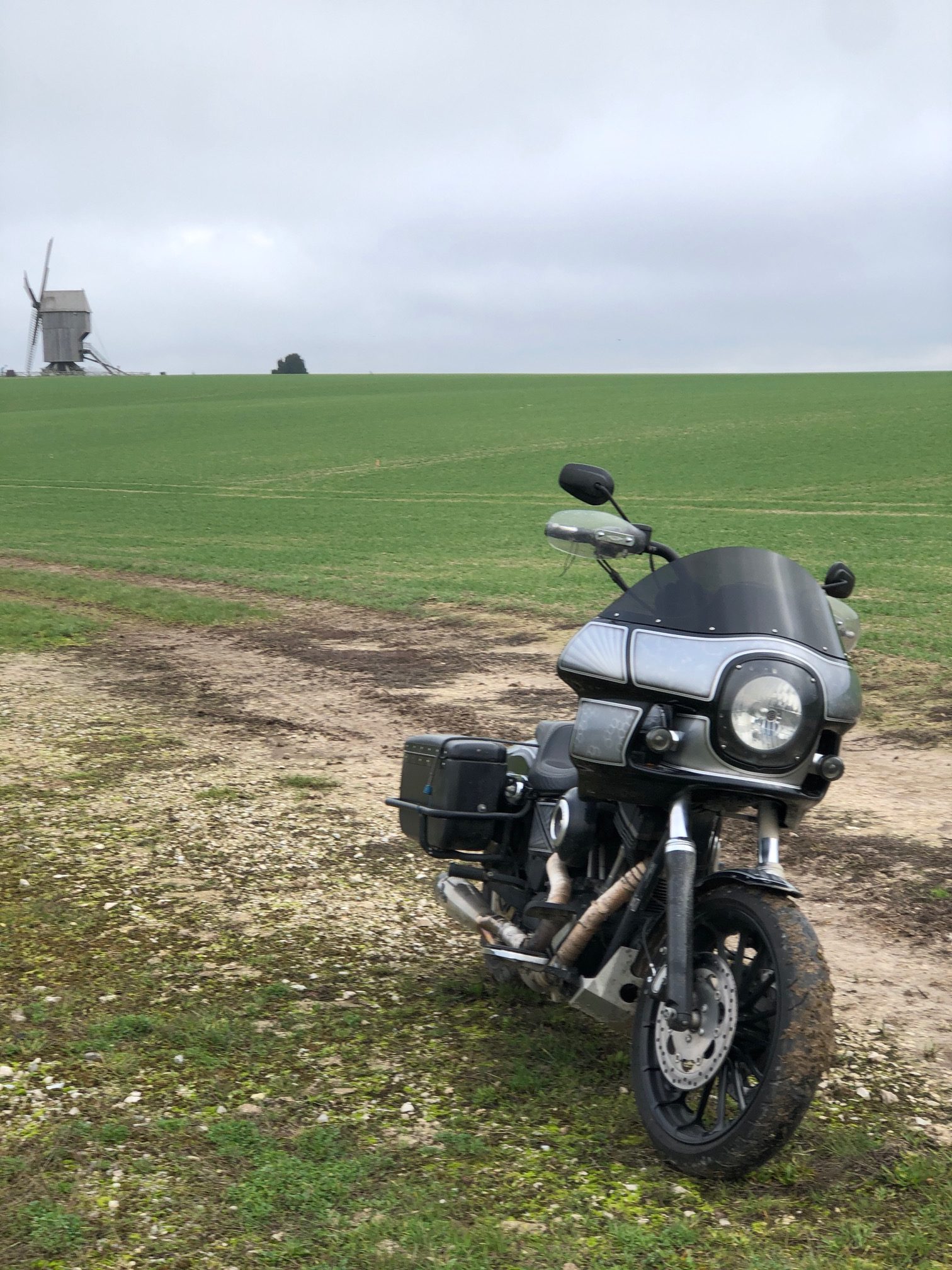 The idea: having a little 450 kilos (280 miles) ride during the day, a
The idea: having a little 450 kilos (280 miles) ride during the day, a
departure in the morning from Paname (it’s the nickname of PARIS) and return
before nightfall, a lot of small try to learn something – something that can
always be used to play the French arrogant at the next party …
 Go East!! Village after village: Coulommiers (and its famous cheese) …
Go East!! Village after village: Coulommiers (and its famous cheese) …
 … and then along the Grand Morin river, to La Ferté-Gaucher, Montmirail,
… and then along the Grand Morin river, to La Ferté-Gaucher, Montmirail,
to find the Petit-Morin river, then Croizar-Joches. Here you join
Bergères-les-Vertus and then riding the official touristic road of
CHAMPAGNE, you go straight on to Chalons-en-Champagne. Deep in France !
 Frankly, this last road, the D933, has no interest. It’s a long straight
Frankly, this last road, the D933, has no interest. It’s a long straight
line … except that it will allow you some cool photo stop. That will keep
you busy because in these times of f…..g covid, forget your usual stop in
local bars / Bistros and their hot coffee …
At Vertu village, at the roundabout make a stop for a pic with the giant
bottle.
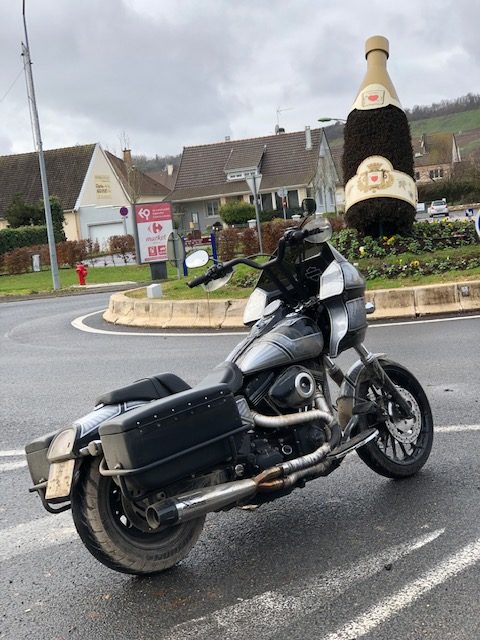 And then, above all, a few kilometers further, after returning on the D933,
And then, above all, a few kilometers further, after returning on the D933,
the photo that every good Parisian biker must have done once in his life on
two wheels …
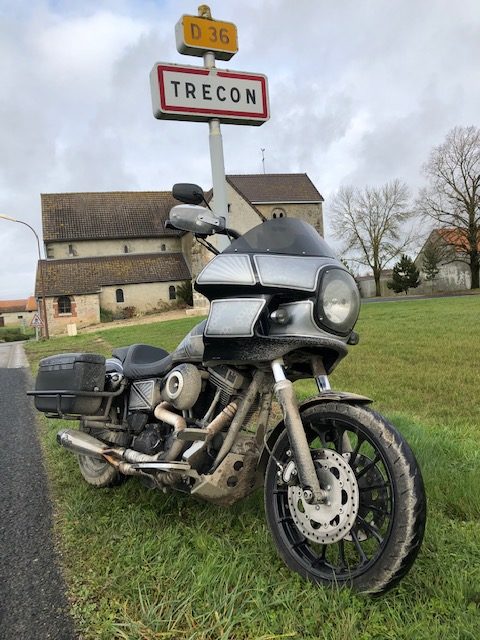 In French TRECON, literally sounds like « Very stupid » … Yes, I know, I
In French TRECON, literally sounds like « Very stupid » … Yes, I know, I
know, it’s very … stupid … (I still wonder how the inhabitants of this
village are named … but I’ve never dared to ask them …).
Go, hop, return on the D933 to the crossroads of the battle of Champaubert
which as you already know is one of the battles of the campaign of France
which takes place from the end of December 1813 to April 1814 and during
which, the Boss, Napoleon 1st tries to stop the invasion of France and keep
his throne. Despite several victories, including that of Champaubert, and
after the entry of Prussian and Russian troops into Paris, the emperor
abdicated on April 6, 1814 and went into exile on Elba Island …
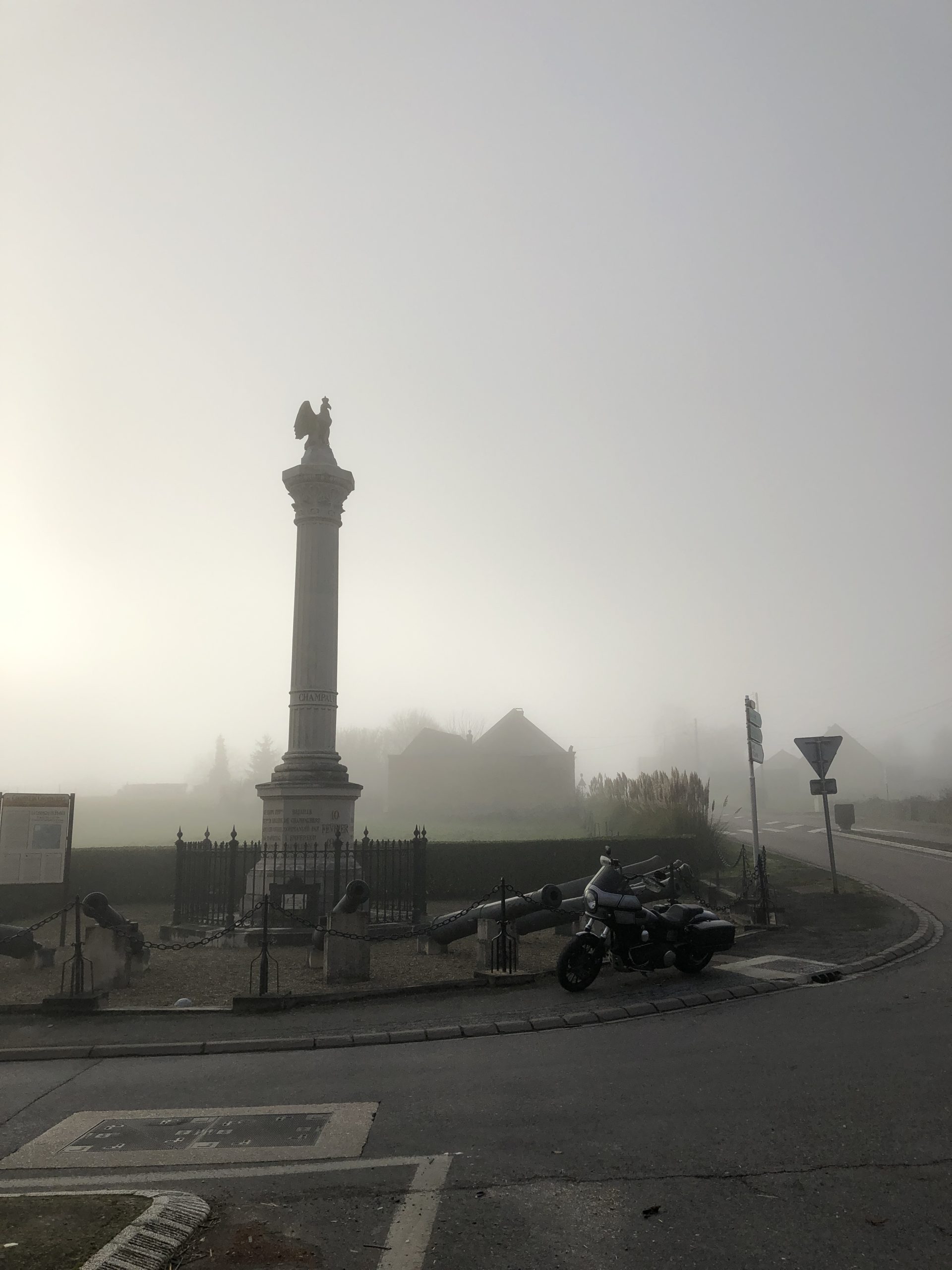 At this stage of your trip that day, not only is it starting to seriously
At this stage of your trip that day, not only is it starting to seriously
sting in the underpants, it still slips as much in alternation of mists and
magnificent lightnings, but it becomes more and more obvious that it will be
difficult to remain presentable. I dare not say clean … it’s starting to
make the real hell biker killer look !!!
 Anyway, as the old Swahili proverb says, which I like a lot: – “Real riders
Anyway, as the old Swahili proverb says, which I like a lot: – “Real riders
have dirty bikes” … Which also suits me well, not being a big fan of the
rag … which in the Harley world makes me look at best for a fanciful (who
rolls) at worst for a heretic (who rolls …him!!) …
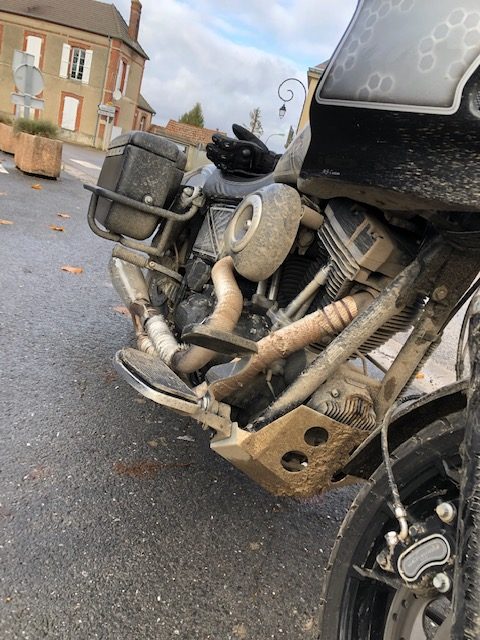 Go, hop, in the saddle, it’s off again, straight on Chalons-en-Champagne
Go, hop, in the saddle, it’s off again, straight on Chalons-en-Champagne
which we cross through the city center, direction Verdun on the D3N3 (due
east), and 20 minutes later you arrive at the intersection with a tiny road
which, in the middle of nowhere, will leave you at the gates of the villge
of VALMY, finally!
 Very famous in the history of France, this small village of almost 300 souls
Very famous in the history of France, this small village of almost 300 souls
seems almost isolated from the rest of the galaxy. Being there, alone in the
heart of this winter, we understand that infantery, cavalry and other
artillerymen have come here to have fun over the centuries, there is no lack
of space …
 As far as the eye can see …the distance …the horizon …
As far as the eye can see …the distance …the horizon …
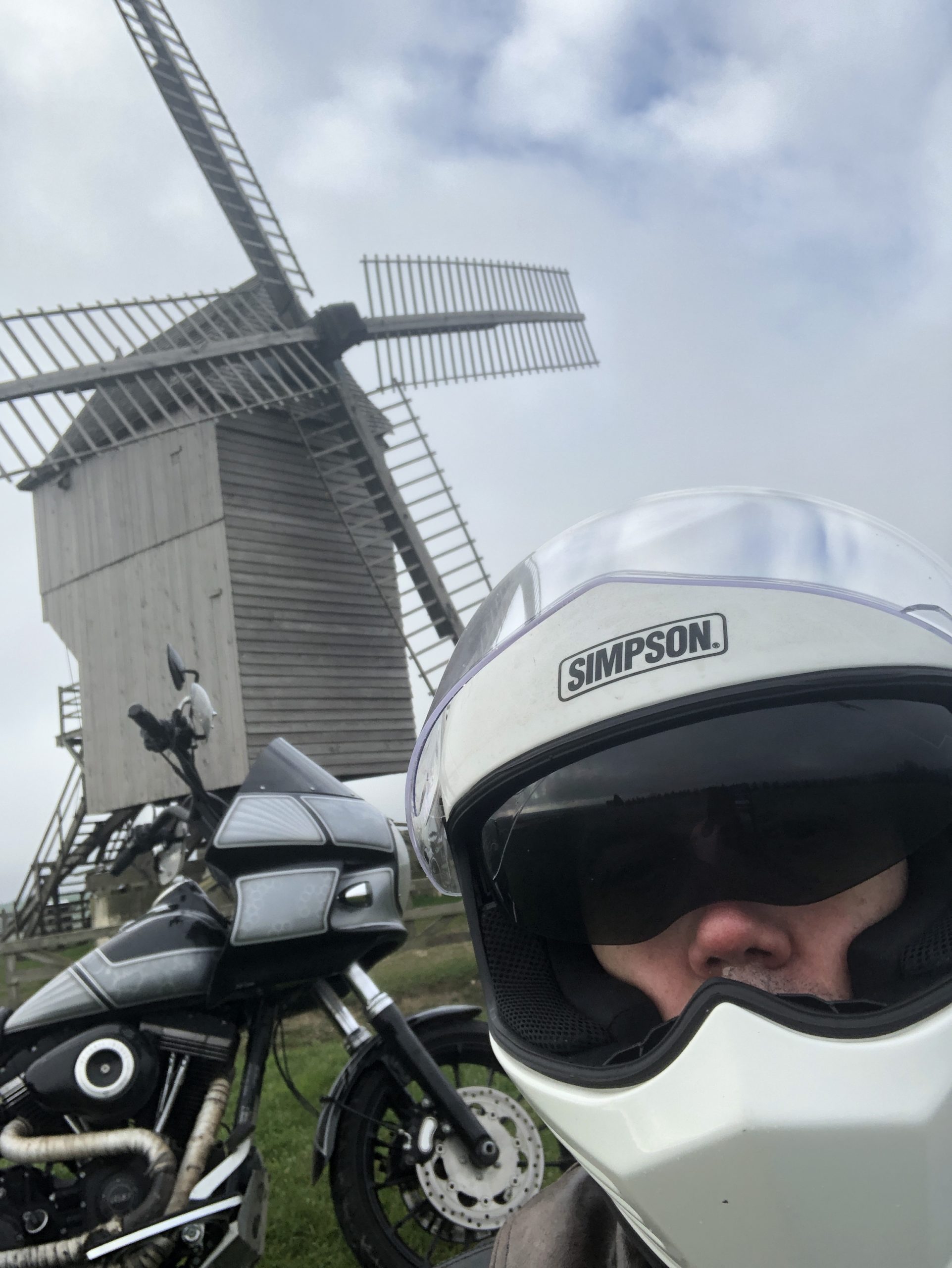 And on these plateaus, a frozen wind crosses everything … it is 1:30 p.m.,
And on these plateaus, a frozen wind crosses everything … it is 1:30 p.m.,
I have trouble taking my photos because I am trembling. That said, all is
well, it’s happiness on tires, there is no living soul, the site is entirely
mine (especially not to slip and drop the 350kg bike because otherwise you
sleep here this evening my little rabbit).
Snotty red nosed cold biker happy to be there. Yeaah!
Here, took place the Batle of Valmy!
 Painting of the Battle of Valmy by Horace Vernet from 1826.
Painting of the Battle of Valmy by Horace Vernet from 1826.
The white-uniformed infantry to the right are regulars while the blue-coated
ranks to the left represent the citizen volunteers of 1791.
Also called the Battle of the Camp of the Moon (it’s neat as a Star Wars
episode that name!!), is the first decisive victory of the French army
during the Revolutionary Wars that followed the overthrow of the Bourbon
monarchy (The King of Prussia having stayed in an inn called Auberge de la
Lune, the bivouac of his army took the name of Camp de la Lune) …
 Although little more than a skirmish during the French Revolutionary Wars,
Although little more than a skirmish during the French Revolutionary Wars,
Valmy was one of history’s decisive battles; the Prussian march on Paris to
restore the French monarchy was halted and the French Revolution saved. The
Prussians and their allies withdrew, allowing the French to renew their
invasion of the Austrian Netherlands.
 Alarmed by the growing radicalization of the French Revolution, Austria and
Alarmed by the growing radicalization of the French Revolution, Austria and
Prussia signed the Declaration of Pillnitz in August 1791; it threatened
military action if the trend toward republicanism in France continued. It
served only to encourage the revolutionaries to take more extreme action,
which eventually led to the imprisonment of the French monarch, Louis XVI.
Prussia and Austria began to mobilize their forces, joined by French émigré
Royalists determined to overthrow the revolution. With conflict inevitable,
the French government anticipated events by declaring war against Austria on
20 April 1792 and invading the Austrian Netherlands (roughly modernday
Belgium and Luxembourg).
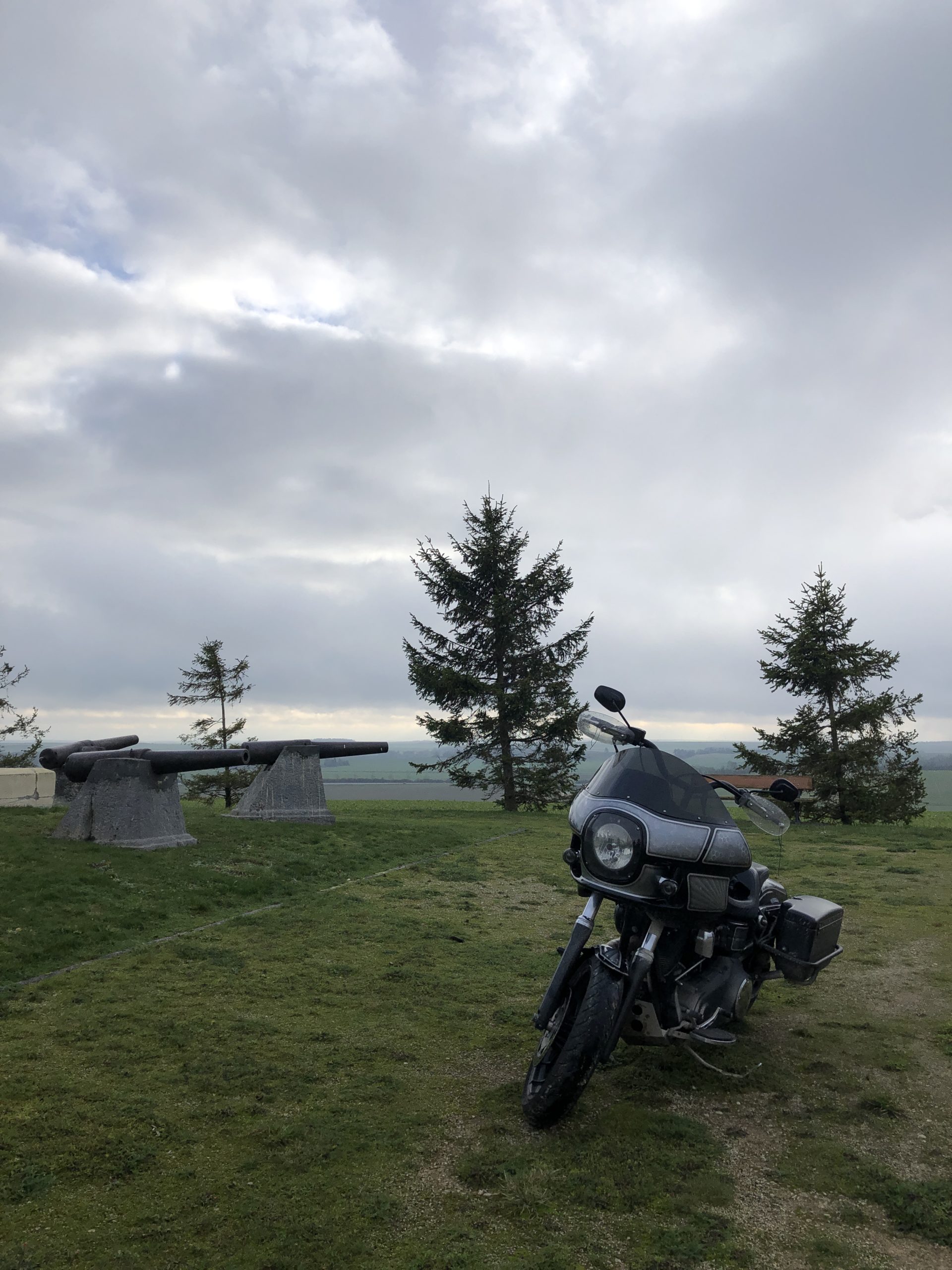 The turmoil of the revolution had seriously affected the efficiency of the
The turmoil of the revolution had seriously affected the efficiency of the
French army, with many of its aristocratic officers fleeing abroad. The
extent of the army’s instability was revealed in the failed invasion of the
Austrian Netherlands-some French units broke and fled after killing their
officers. The monarchist powers were encouraged by this turn of events, and
Prussians, Austrians, German mercenaries, and French émigrés began to
assemble their forces. A Prussian army, under the command of the Duke of
Brunswick, invaded eastern France in August, capturing the fortress cities
of Longwy and Verdun as a preliminary act to a march on Paris itself.
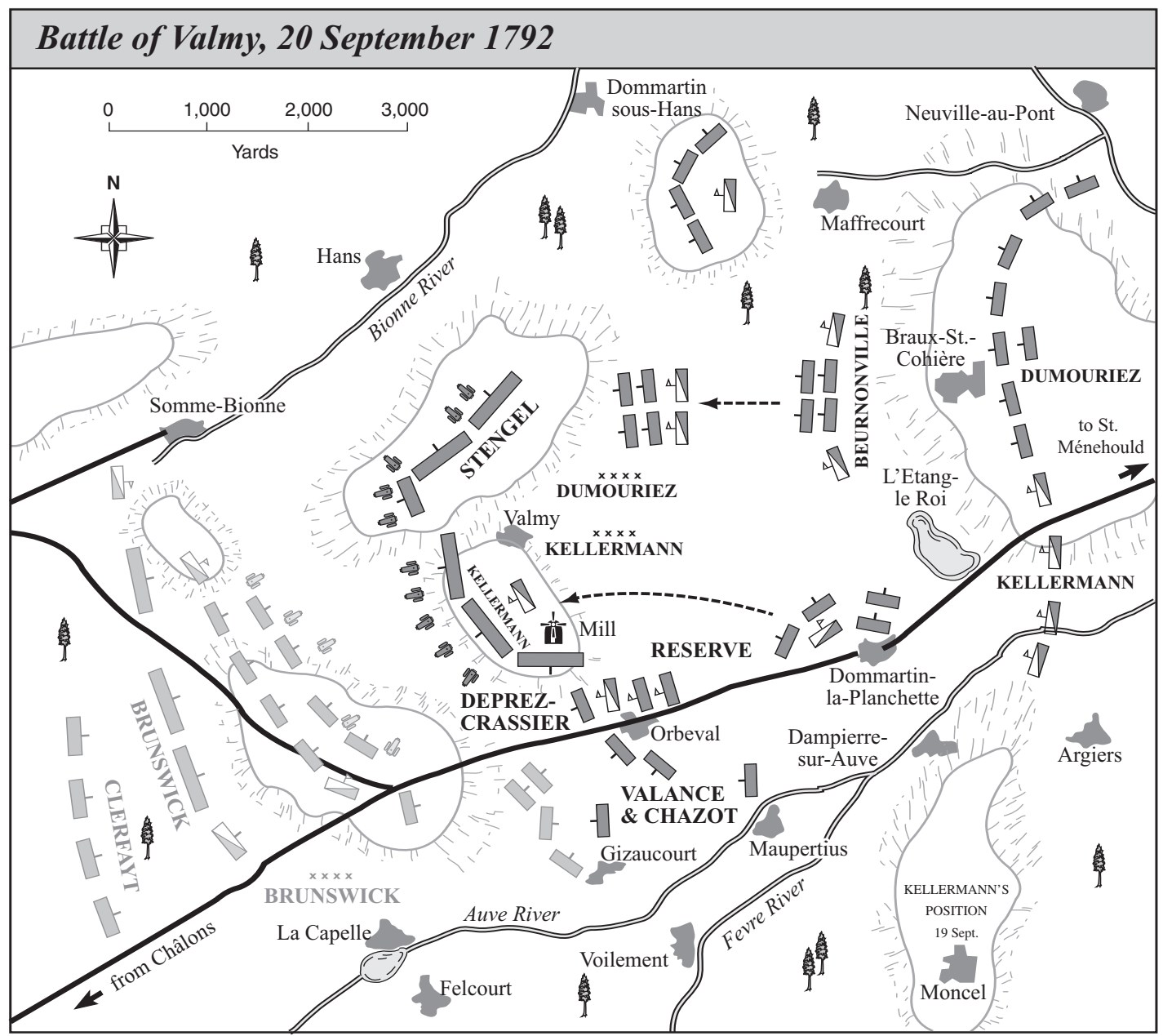 Two small French armies opposed the Prussian advance: the Army of the North,
Two small French armies opposed the Prussian advance: the Army of the North,
led by General Charles Dumouriez, and the Army of the Center, under the
command of General François Kellerman. In the manner of eighteenth-century
warfare, the two national sides maneuvered against each other until
Dumouriez placed his troops against the Prussian line of march. He was
joined by Kellermann, who advanced beyond Dumouriez’s Army of the North to
take up a position on high ground around the village of Valmy, directly in
front of the Prussians. Kellermann set up his command post by a windmill at
the center of the French line. The French forces were a combination of
enthusiastic but ill-trained volunteers and experienced regulars from the
old royal army, supported by the technically proficient French artillery.
 As the mists cleared on 20 September, Prussian and French artillery opened
As the mists cleared on 20 September, Prussian and French artillery opened
fire in a long-range duel that caused few casualties on either side (the 36
French cannons fired 20.000 bullets there). Brunswick then ordered his
troops forward in the hope that the French would break and run at the sight
of the famed Prussian infantry. However, the French held firm, and Brunswick
withdrew his troops to allow his artillery to continue to soften up the
French positions. A second assault was ordered, which coincided with a lucky
Prussian cannon shot detonating a French ammunition wagon by the windmill.
Again the French line did not waver, and, in the face of heavy musketry
fire, the Prussians retreated.
 This marked the end of the battle, although the armies remained facing each
This marked the end of the battle, although the armies remained facing each
for some days until the Prussians withdrew from French territory. The poet
Goethe witnessed the battle and prophetically wrote: “From this day forth
begins a new era in the history of the world.”
Losses: French, 300 casualties of 32,000 engaged; Prussian, 180 casualties
of 34,000.
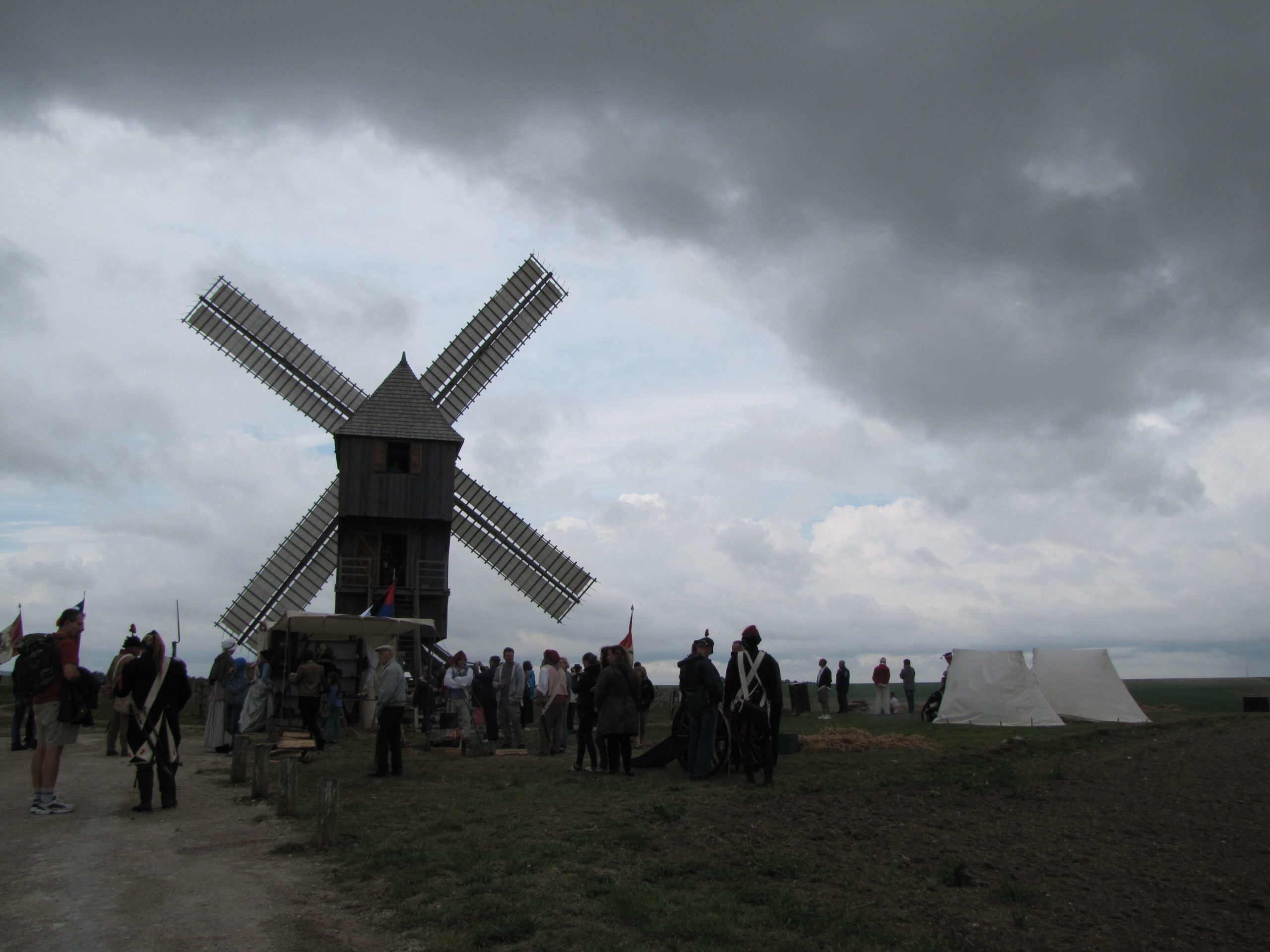 In those first months of the Revolutionary Wars – later called the First
In those first months of the Revolutionary Wars – later called the First
Coalition War – the new French government was almost without legitimacy;
therefore, the victory at Valmy became a decisive psychological victory for
the Revolution and its supporters. The outcome of the battle is considered
“miraculous” and is presented as a “decisive defeat” of the Prussian army.
After the battle, the young National Convention was sufficiently
reinvigorated to declare the official end of the monarchy in France, and the
advent of the First Republic. Valmy allows the Revolution to take hold, thus
being considered one of the most decisive battles in history. In short, this
is where contemporary France takes its roots …
A chapel was also built on the site. It contains the ashes of the Princess
Ginetti, great-granddaughter of general Kellermann, who through her donation
had enabled the site to be developed …
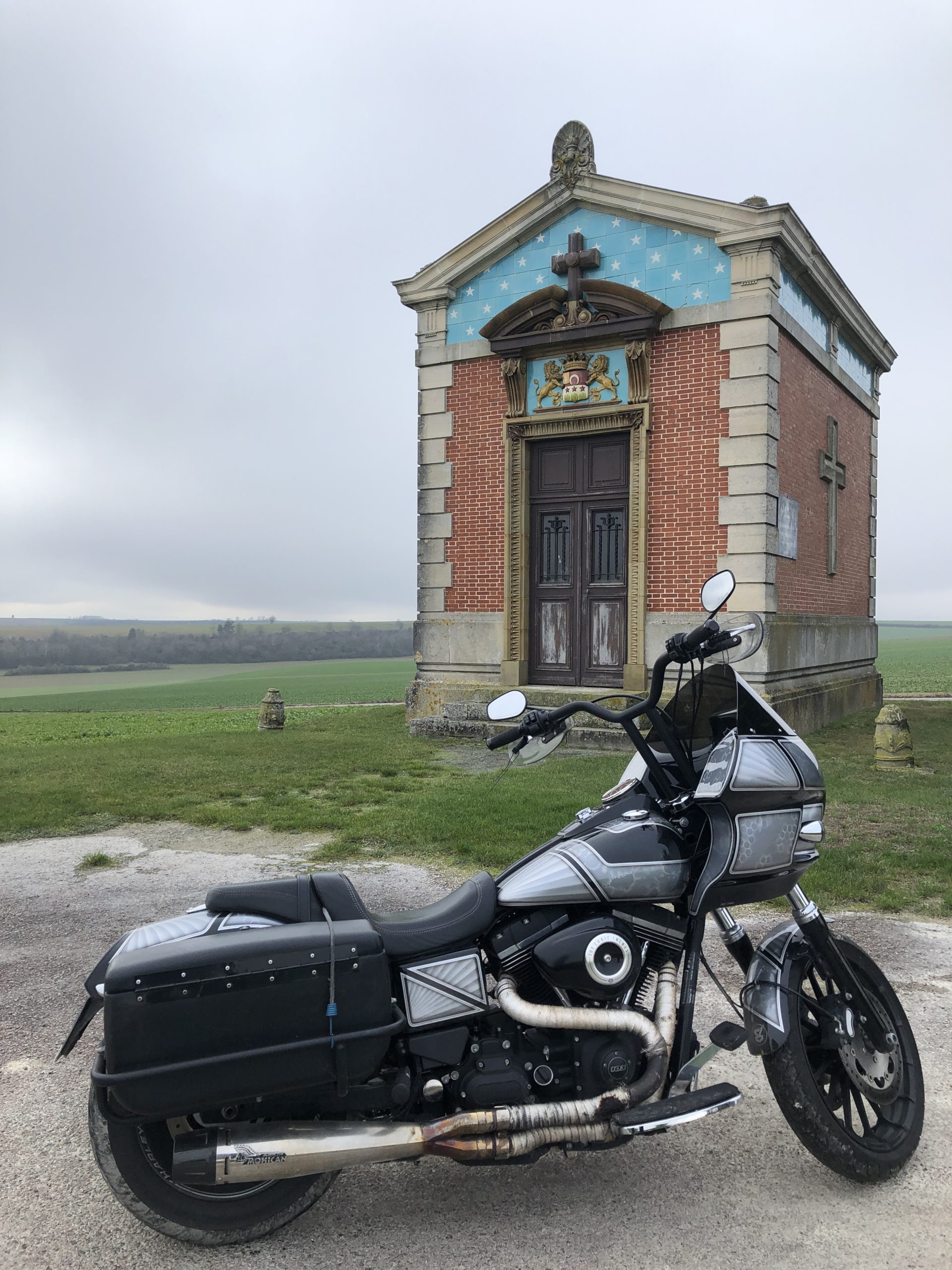 The historic center Valmy 1792 (closed of course that day) opened in 2014.
The historic center Valmy 1792 (closed of course that day) opened in 2014.
Located below the mill (“The Valmy Mill is located on the highest point in
the region where general Kellermann concentrated his artillery, overlooking
the plain), its architecture is semi-underground. It offers a visit to the
heart of the revolutionary turmoil and allows you to understand the issues,
the course and the consequences of this battle. A large model in relief and
animated allows to understand the strategy imagined by Dumouriez …
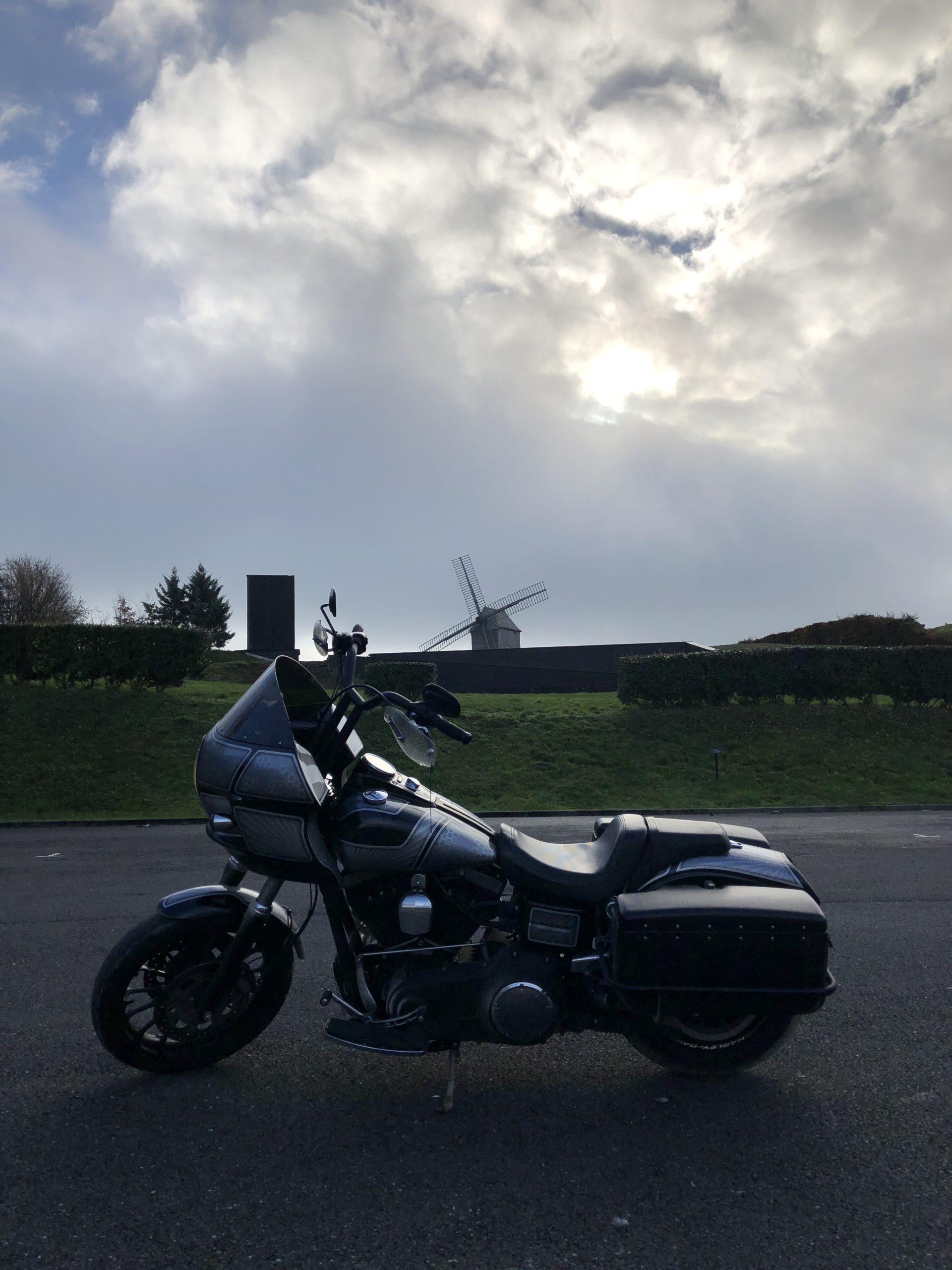 Ok, when you come back down from the site, you’ll still take a look at your
Ok, when you come back down from the site, you’ll still take a look at your
tires, for sure the mud shouldn’t have made them slippery … And then, yes,
let’s still go up the main street of Valmy to see what looks like.
 And there, surprise, it commemorates on all sides …
And there, surprise, it commemorates on all sides …
Several foreign generals distinguished themselves at Valmy, the most famous
being undoubtedly Francisco de Miranda (1750-1816). His statue still recalls
the role he played in this French region of Argonne in 1792. Arriving for
the second time in France in March 1792, Francisco de Miranda, a Venezuelan,
was appointed Brigadier in the army of the Meuse. After military exploits,
he became a general and participated in the artillery duel of the Battle of
Valmy …
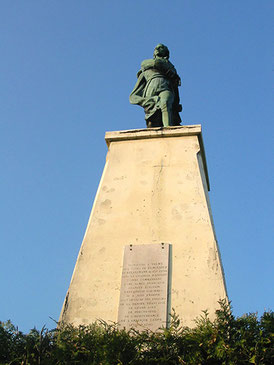 Back in South America, he fought alongside Bolivar for his country’s
Back in South America, he fought alongside Bolivar for his country’s
independence. Beaten by the Spaniards, he was imprisoned in Cadiz where he
died in 1816 … on July 14. Wait, it’s not over … A few meters from the
statue of Miranda, the bust of Simon Bolivar recalls this other hero from
Venezuela. He was not present at the battle of Valmy ..
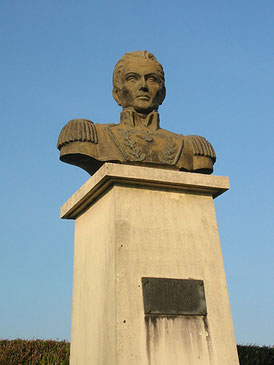 General Simon Bolivar had resumed the work of liberating South America from
General Simon Bolivar had resumed the work of liberating South America from
Miranda and freed Venezuela from Spanish rule for the second time (1822).
Also, as a souvenir, his bust was installed in 1983 in front of the statue
of Miranda …
Wait, I tell you, it’s still not over!
When it comes time to turn around: bingo, you come across what is called a
“military flowerpot tank” …
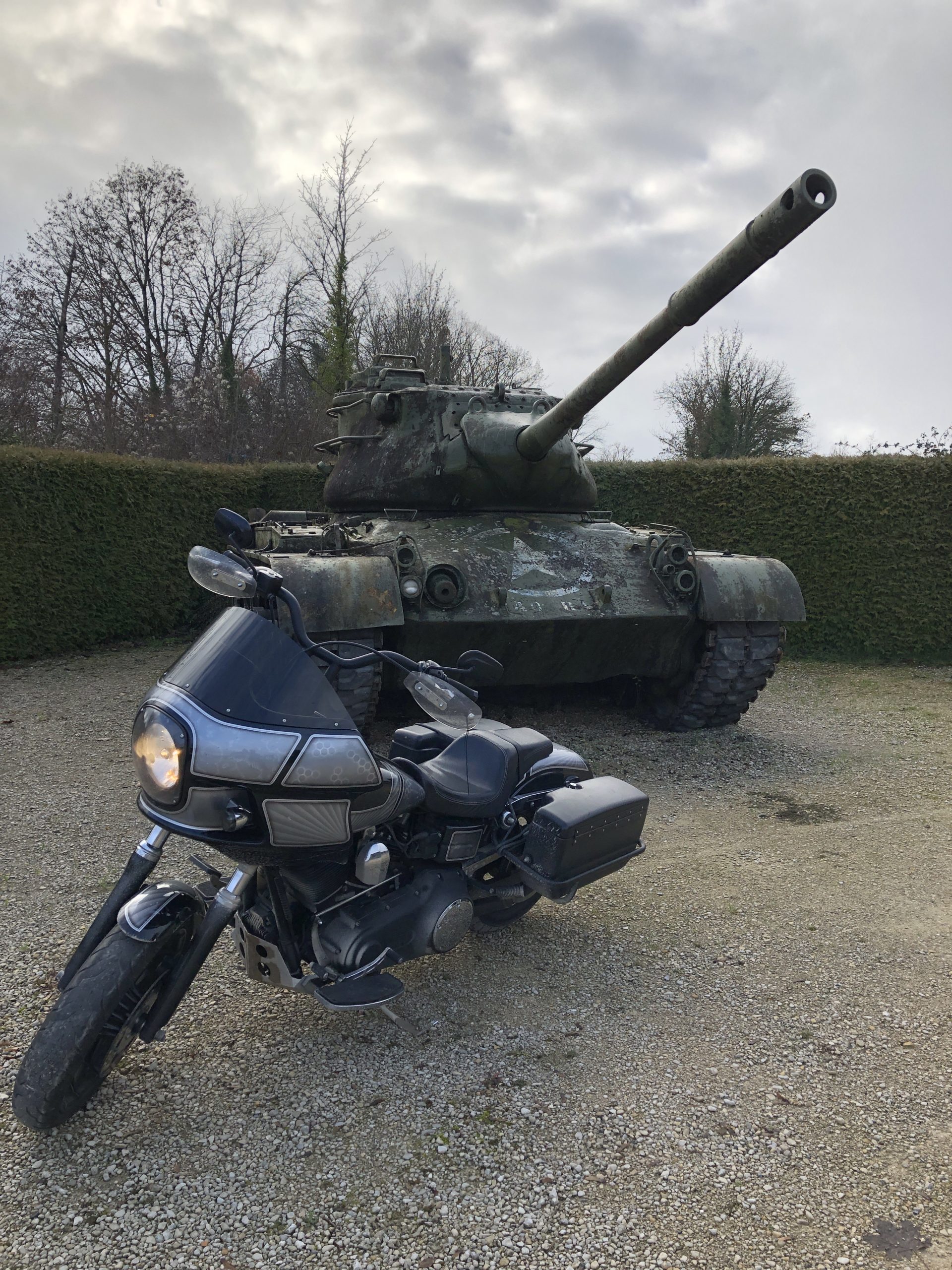 A few meters after the statue of Miranda, an M-47 Patton tank rotting on
A few meters after the statue of Miranda, an M-47 Patton tank rotting on
tracks, not valued, without the slightest maintenance or any other
commemorative / explanatory plaque … It sucks, frankly, what a shame!!
 The M47 PATTON medium tank, is intended to replace all SHERMAN M4 and M26
The M47 PATTON medium tank, is intended to replace all SHERMAN M4 and M26
developed during the Second World War and which turn out to be really weak
vis-à-vis the competition. It is the second tank named after Patton. Little
used by the US Army and US Marine Corps, it is widely delivered to NATO and
NATO countries through the Military Assistance Program …
 There is very little information on the Patton de Valmy. It was given to the
There is very little information on the Patton de Valmy. It was given to the
town (by the French army I suppose) to commemorate the liberation of Valmy
in August 1944 by General Patton’s third army … many people think that
this tank participated in this event, this which is technically impossible
since this model was produced from the fifties …
Finally, after two hours spent in this very small village, lost on the
plateaus to the east between Paris and Verdun, I am amazed by the
concentration of major historical information it offers. What a fantastic
discovery, I learned a lot today.
Come on, it’s time to come back home. I still have two photos to take on the
way back (before the night) that I wanted to take for a long time in a very
small village called Bellot.
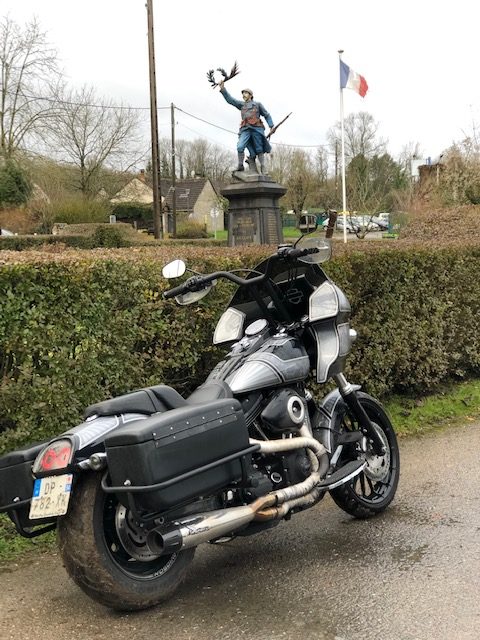 The superb infantryman painted in the village square (WWI).
The superb infantryman painted in the village square (WWI).
An 100 meters further, the very UrbEx photo in front of the old cider and
derivatives factory (I still wonder what these famous derivative could be)
…
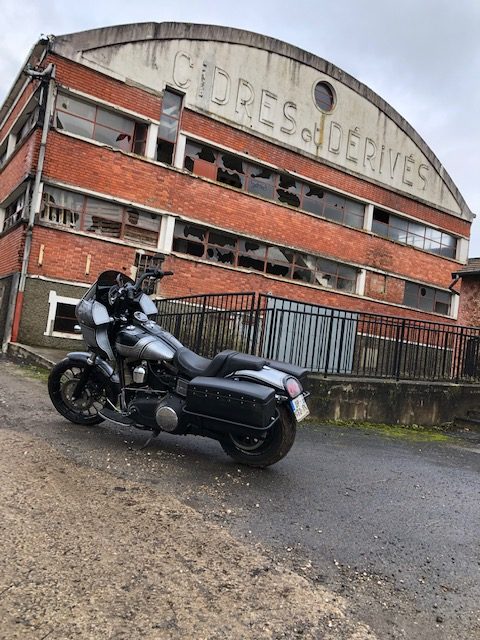 Frankly, this little outing in Valmy kept all its promises, it was worth it!
Frankly, this little outing in Valmy kept all its promises, it was worth it!
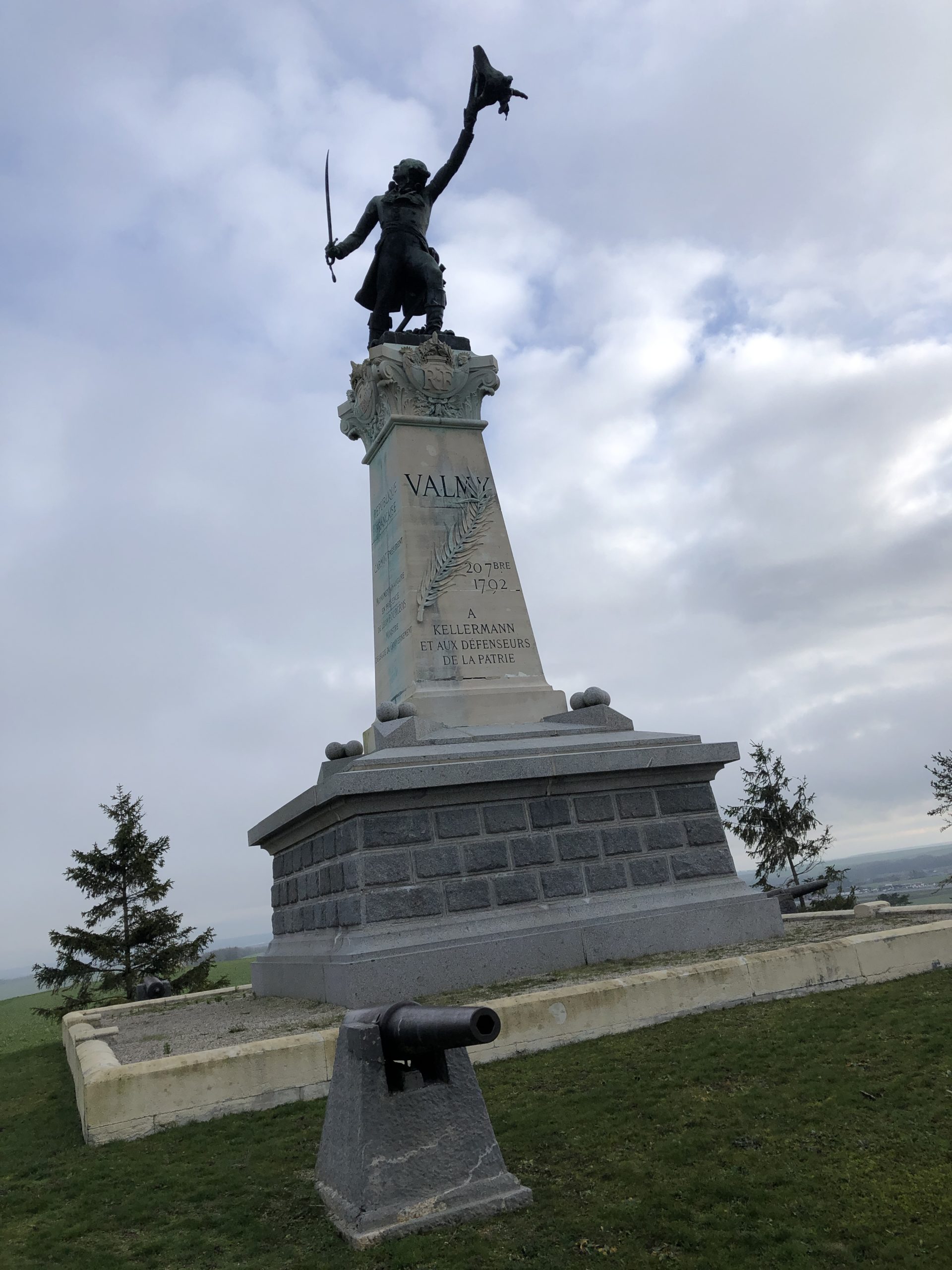 Next time you will be in France, we’ll talk about Revolution …
Next time you will be in France, we’ll talk about Revolution …
See you soon on the road …who knows??





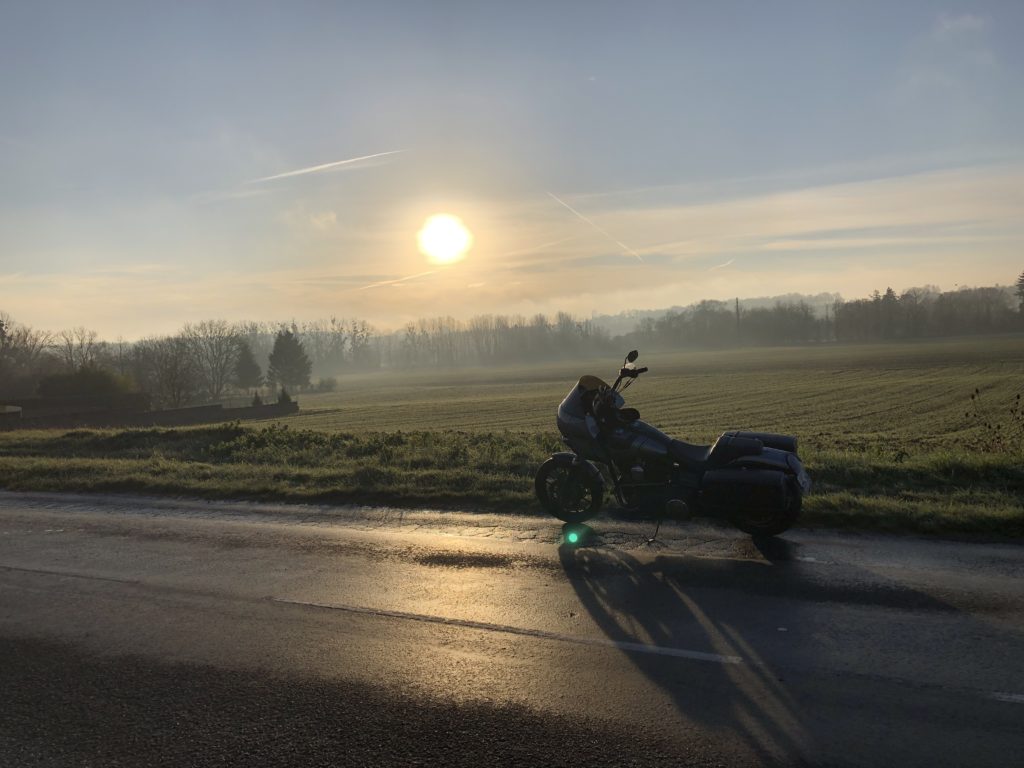
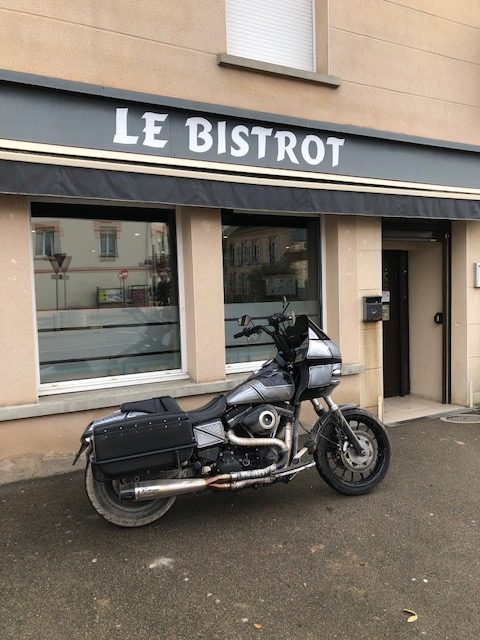

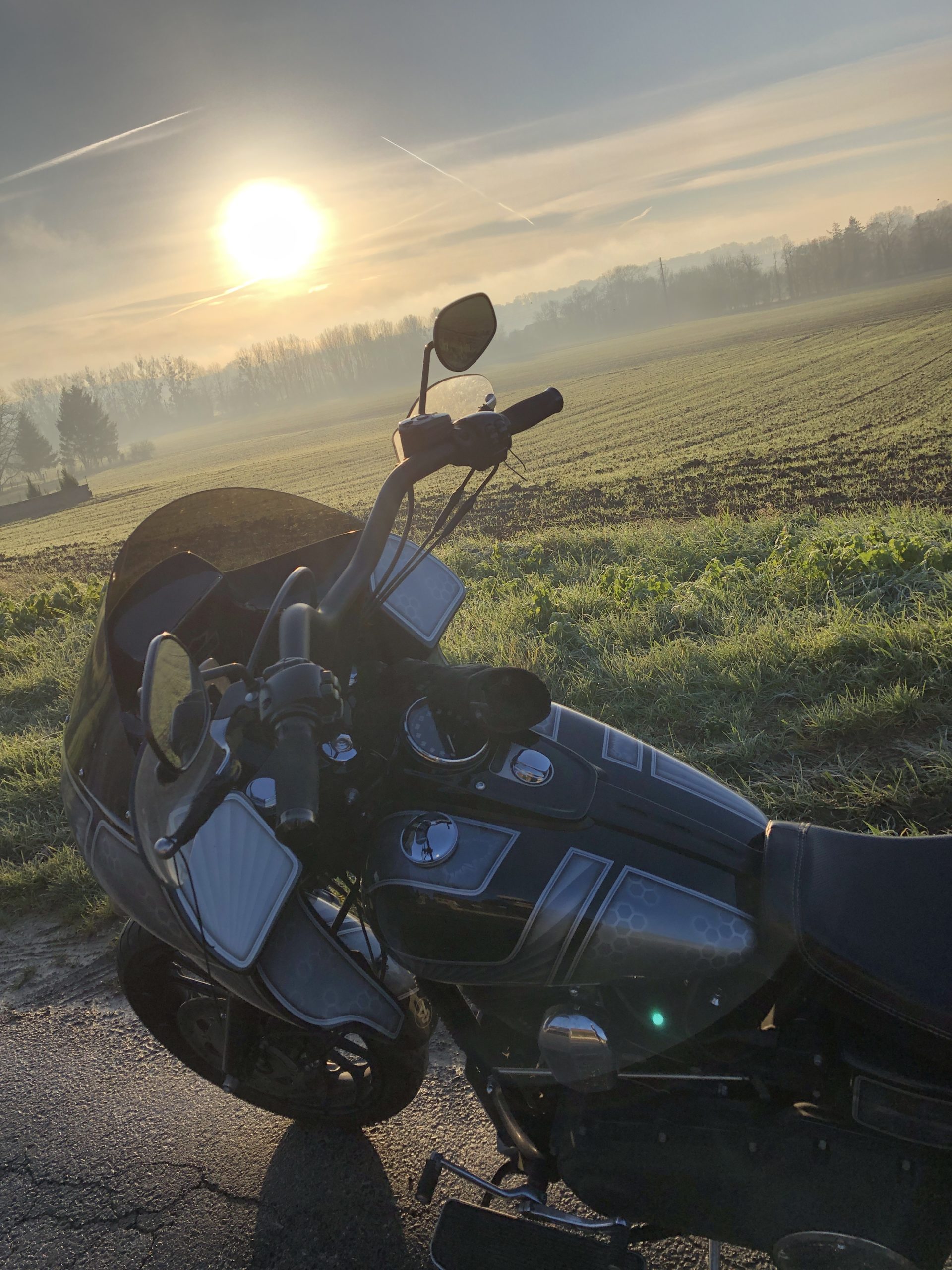
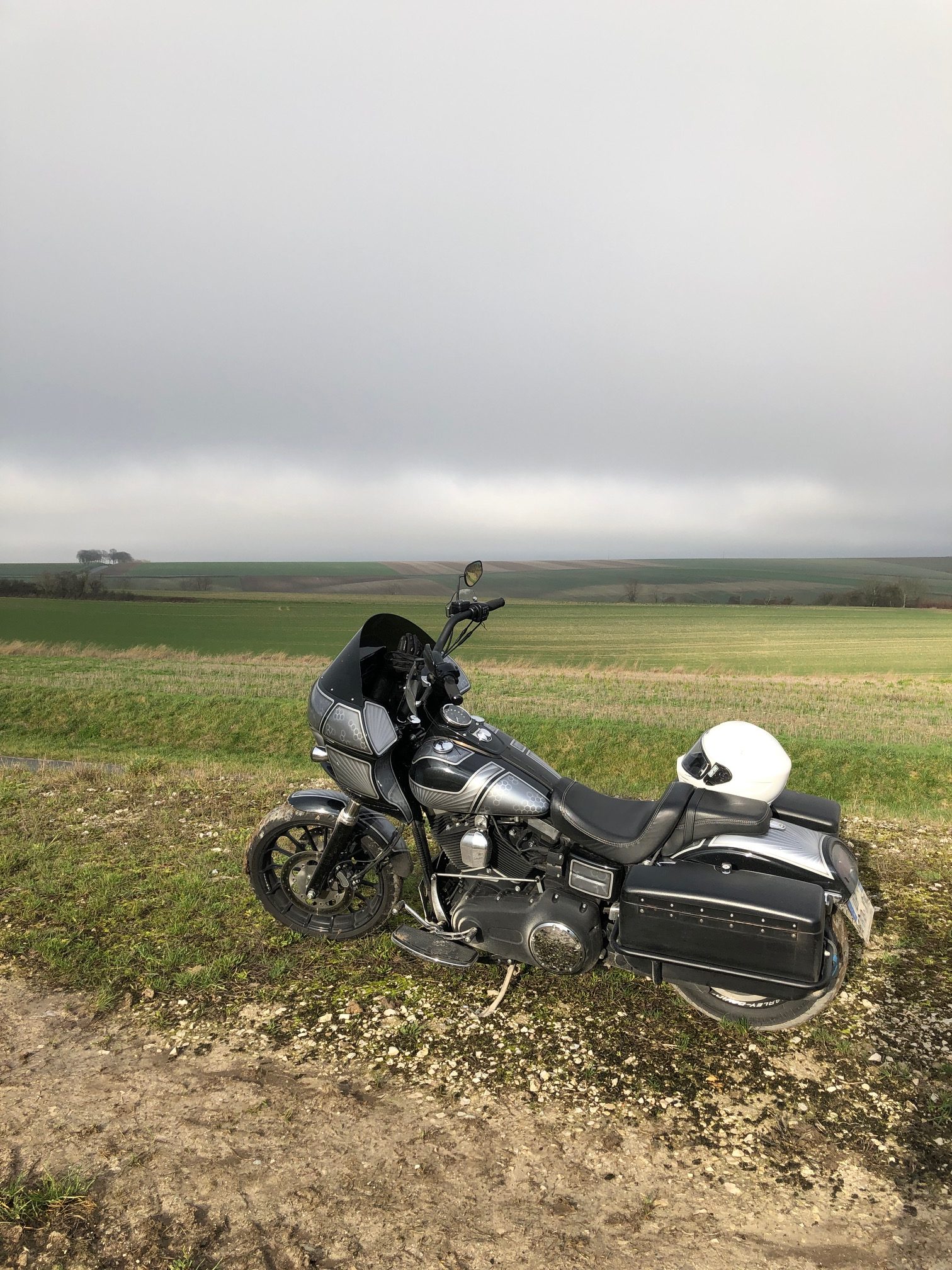
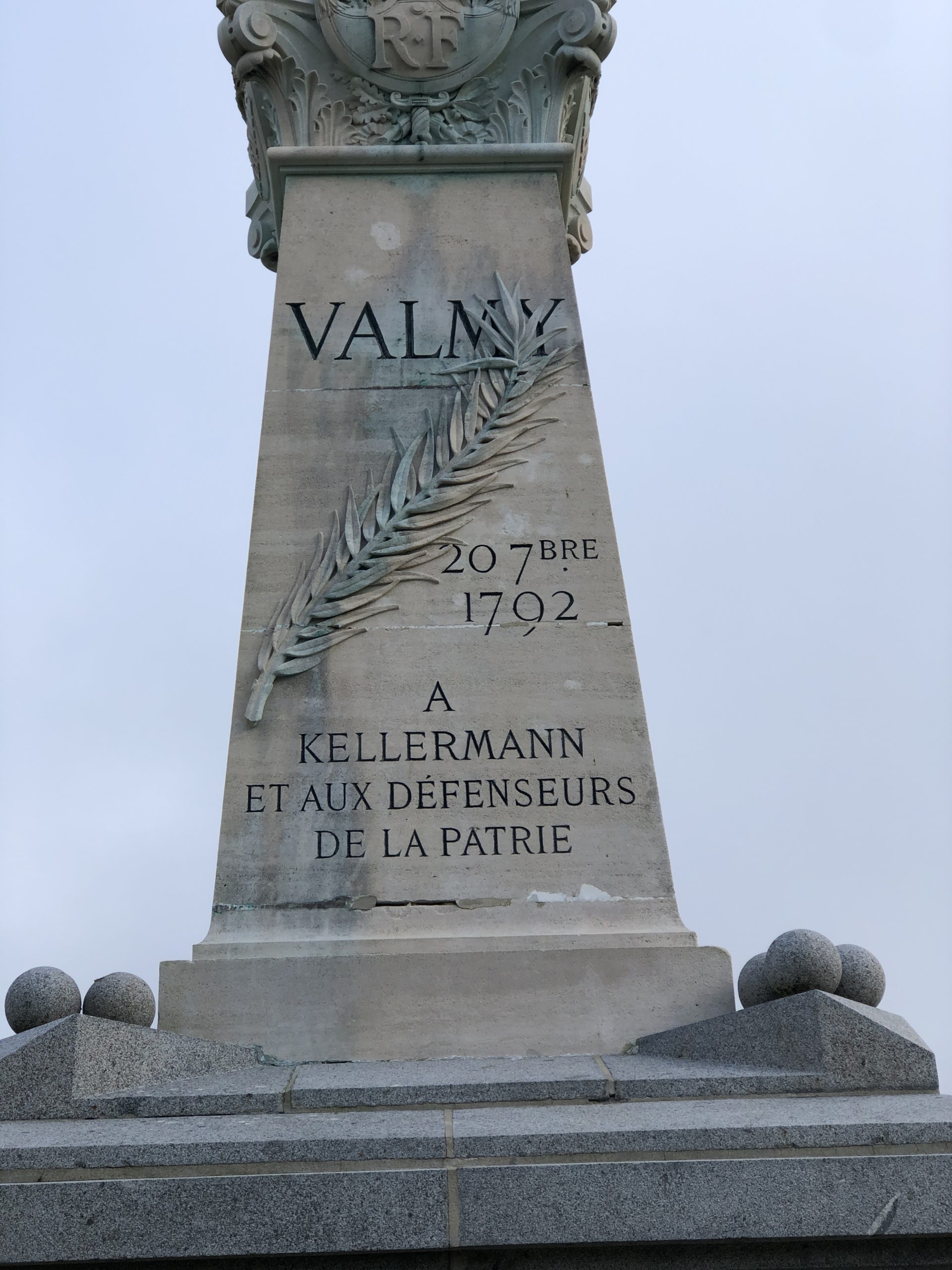
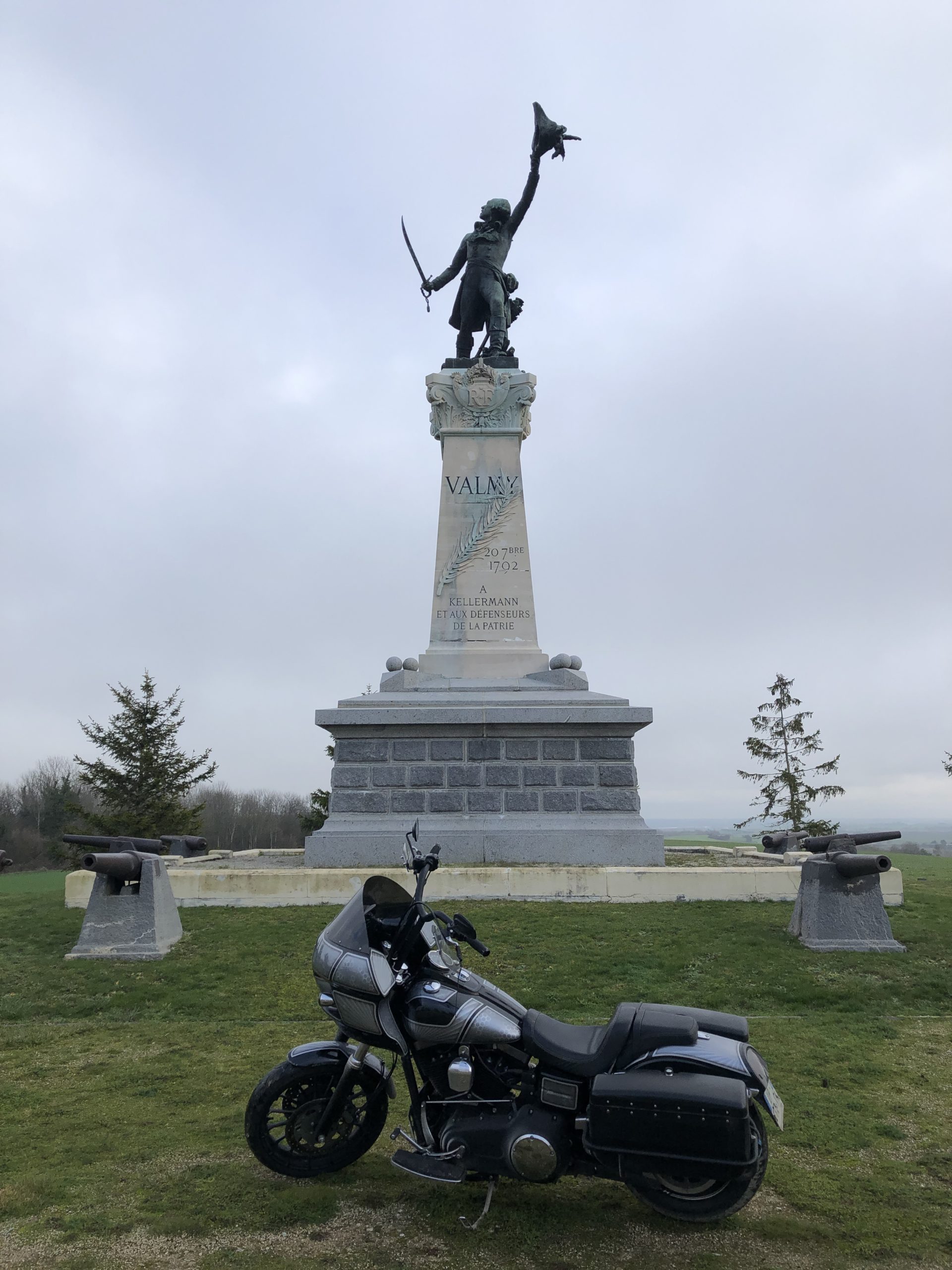


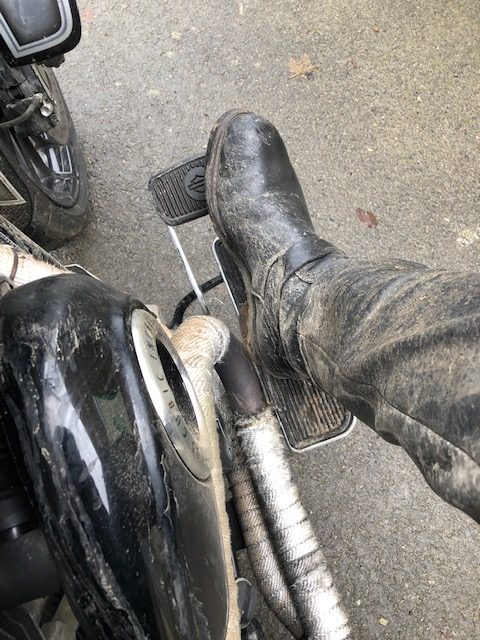
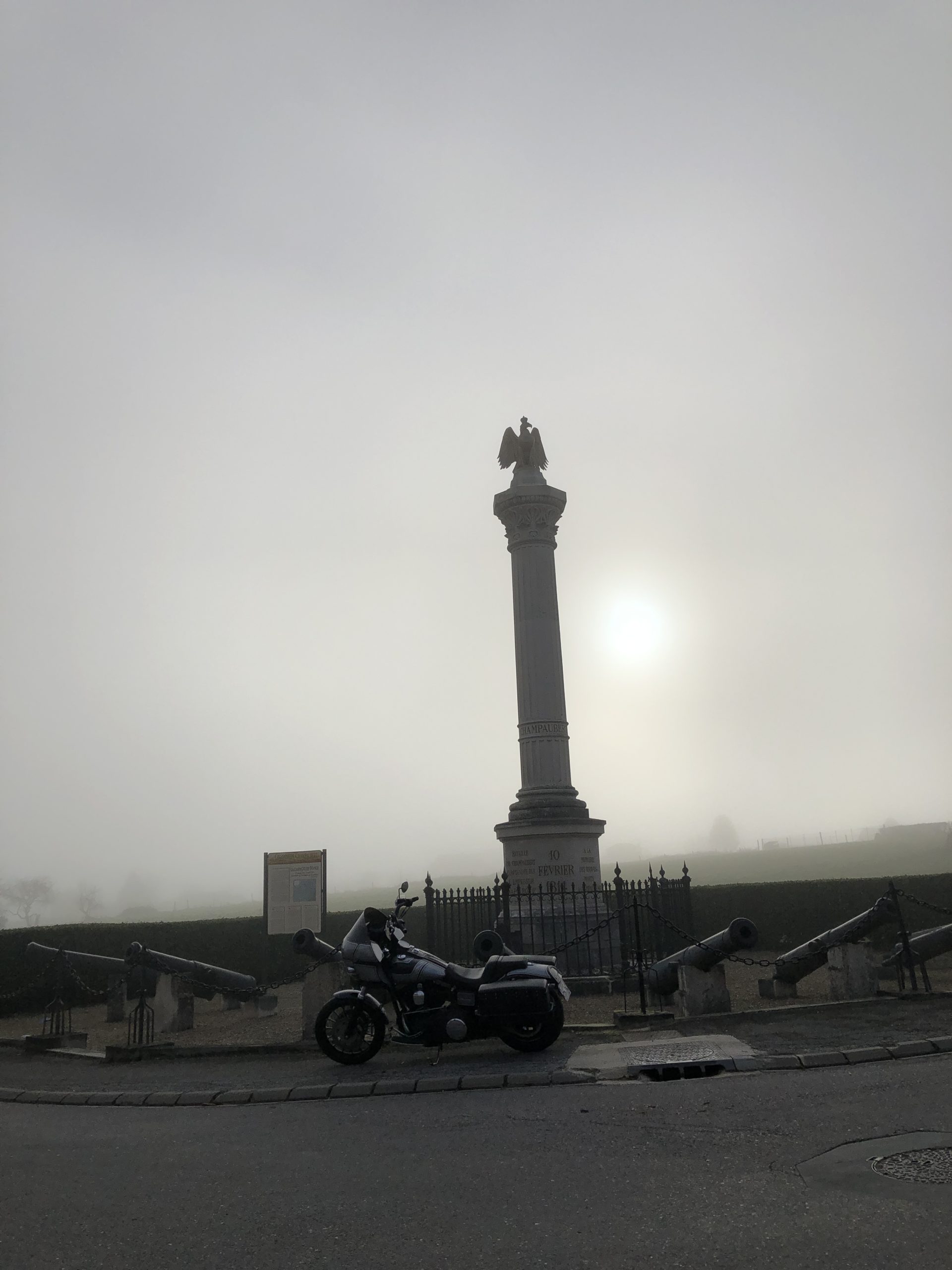
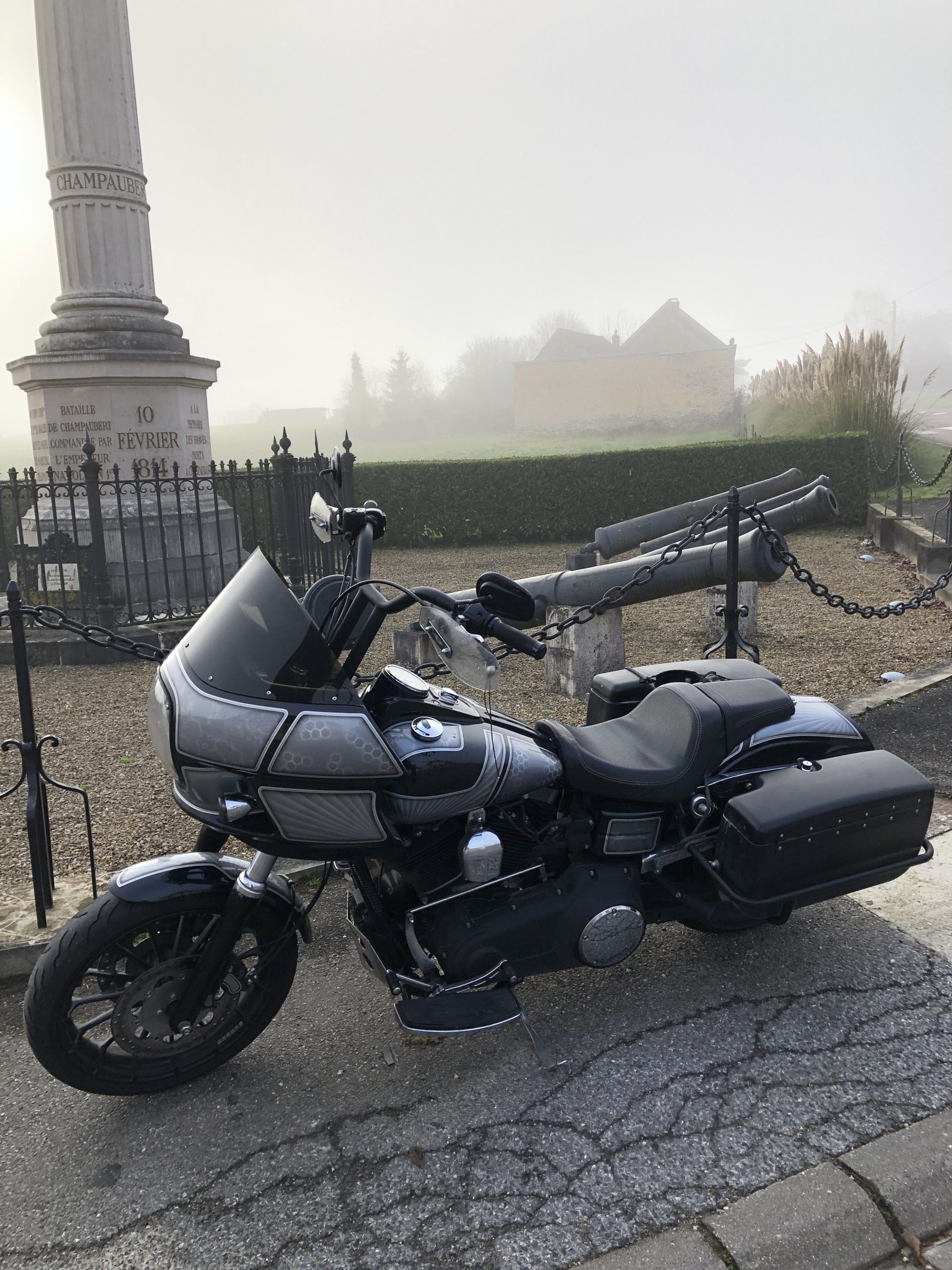



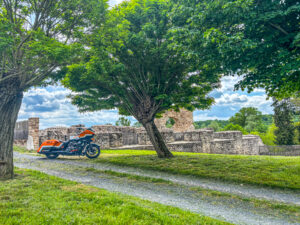
More Stories
RIDE TO THE GALLO-ROMAN SITE IN THE CENTER OF FRANCE
RIDE TO THE CASTLES
RIDE TO THE VALENCIA MARKET